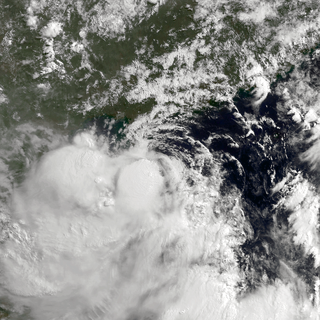Top Qs
Timeline
Chat
Perspective
Tropical Storm Bebinca (2013)
Pacific tropical storm in 2013 From Wikipedia, the free encyclopedia
Remove ads
Tropical Storm Bebinca, known in the Philippines as Tropical Depression Fabian, was a weak tropical cyclone that brought minor damage in China and Vietnam, causing a death and an economic loss of about US$13 million.[2][3] The sixth depression and fifth named storm of the season. Bebinca originated as a low-pressure area south of Hong Kong. As the disturbance is moving westward, favorable conditions allow the system to organize into a tropical depression. On June 21, the depression was upgraded into a tropical storm despite the wind shear, which generated by a subtropical ridge.
Bebinca slightly weakened back into a depression and made landfall over Hainan. It remained as a depression as it enters Gulf of Tonkin. Bebinca made its final landfall over Hanoi before finally dissipated on June 24.
Remove ads
Meteorological history
Summarize
Perspective

Map key
Tropical depression (≤38 mph, ≤62 km/h)
Tropical storm (39–73 mph, 63–118 km/h)
Category 1 (74–95 mph, 119–153 km/h)
Category 2 (96–110 mph, 154–177 km/h)
Category 3 (111–129 mph, 178–208 km/h)
Category 4 (130–156 mph, 209–251 km/h)
Category 5 (≥157 mph, ≥252 km/h)
Unknown
Tropical storm (39–73 mph, 63–118 km/h)
Category 1 (74–95 mph, 119–153 km/h)
Category 2 (96–110 mph, 154–177 km/h)
Category 3 (111–129 mph, 178–208 km/h)
Category 4 (130–156 mph, 209–251 km/h)
Category 5 (≥157 mph, ≥252 km/h)
Unknown
Storm type
In mid-June, strong but disorganized convection persisted in the South China Sea approximately 1,110 km (690 mi) south of Hong Kong.[4] The disturbance gradually organized, and was classified as a tropical depression by the Japan Meteorological Agency (JMA) at 1800 UTC on June 19;[5] The Philippine Atmospheric, Geophysical and Astronomical Services Administration (PAGASA) followed suit six hours later, naming the system Fabian.[6] Despite wind shear generated by a subtropical ridge, the depression maintained a well-defined circulation, allowing the system to intensify.[7] At 0000 UTC on June 21, the JMA upgraded the cyclone to Tropical Storm Bebinca.[8] Following this upgrade in strength, however, Bebinca leveled out in intensity prior to making landfall on Hainan on June 22. Bebinca's passage weakened the system to tropical depression strength, and, despite moving over the Gulf of Tonkin, failed to restrengthen before making its final landfall on June 23 east of Hanoi.[9]
Remove ads
Impact
Hainan

Sanya Phoenix International Airport cancelled 110 flights and delayed another 37, affecting and stranding 8 thousand passengers.[10] In Beibu Bay, a fishing boat with four fishermen on board became unable to contact land, but were found the subsequent day.[11][12] Rainfall in Hainan peaked at 227 mm (8.9 in) in Sanya. A total of 21.7 million people were affected, and damage amounted to ¥10 million (US$1.63 million).[3]
Vietnam
Several provinces in Northern Vietnam experienced heavy rainfall due to the passage of Bebinca. In Hon Dau, a gust of 26 metres per second (95 km/h; 60 mph) was recorded. Rainfall peaked at 208 mm (8.2 in) in Ninh Bình.[1][13] The agricultural industry was the most severely affected due to damage inflicted to 4,600 hectares (11,000 acres) of marine ponds. Economic losses of VND 1.19 trillion (US$56.5 million) were recorded.[2][14] Floods in Nghệ An Province killed one person; two others went missing.[1]
Remove ads
See also
References
External links
Wikiwand - on
Seamless Wikipedia browsing. On steroids.
Remove ads

